The Cornell Lab Bird Academy › Discussion Groups › Joy of Birdwatching › Activities: Noticing Behaviors
-
I was hiking yesterday in a forested area of Western Massachusetts near the New York border. I didn't see any birds, but I heard quite a few. I recognized four of them. And I didn't know any birdsongs a few weeks ago! I heard the Ovenbird quite a few times. Teacher teacher teacher! I haven't seen one yet, and I can't wait to see one because they look so exotic in the pictures! As we hiked up a hill we started hearing the beautiful haunting song of the Wood Thrush. I've heard it many times in the past but not yet this year. I wasn't sure of my identification, so when we sat down to eat lunch I checked on my phone, and I played it a few times to make sure. The Wood Thrush had been further off but when he heard my phone he came over to investigate! He sang at the top of his lungs for a few minutes right nearby. Could we see him? No way. The other birds I identified were a Chipping Sparrow (there's one my yard too) and a Red Eyed Vireo, which I've heard quite often on my walks.
-
#1: The other day I was gardening in my yard when I saw three crows join together at the top of an electric pole. They appeared to be in some sort of discussion, facing and garbling to one another. Then a blue jay's scolding call comes from a nearby tree, and then the jay joins the crows on the other side of the electric pole (i.e. from a safe distance) and "yelled" at the crows, as if making its case. The crows continued to "discuss" the situation, and after a few more scolds the blue jay flew off. I wonder if the crows had encroached on the jay's territory or taken some food! #2: At our feeder we have had a bunch of different birds that eat different ways. The sparrows eat directly from the feeder, while the cardinals try to eat from the feeder but they are too big and so eat on the ground. The mourning doves eat from the ground as well. The other birds usually leave when a blue jay arrives. The red-bellied woodpeckers hang off the feeder and peck at the seeds. I did see a white-breasted nuthatch take the seed and bang it into the trunk of the tree to open it. #3: I often hear cardinals, robins, song sparrows, blue jays, Carolina wrens, catbirds, eastern peewees, and red-bellied woodpeckers, occasionally crows, and a far-off wood thrush in the evenings. I have been hearing a full melodious song all spring and had been trying to identify the singer for months. It always sounded like it was a few houses away, so our yard must not be in its usual territory. I went on All About Birds, listening to different song recordings of our usual guests - to no avail!! Then, just this morning, right out my window, I heard the song and a little house finch was singing in an arbor vitae. I actually recorded it, because there is nothing like it among the recordings I listened to. I think it must be a regional dialect for the house finch!
-
Activities 1 and 2 merged, with some other lesson-based observations. We have many House Sparrows near and in our yard, and they participate in a dawn chorus around 4:30 or 5 am (first light) in June. It is difficult to detect where in structures they are nesting. They perch in nearby trees and dense bushes or brush. They are regulars at our feeders, eating mainly smaller seeds (not striped sunflower) and millet, many at the feeding area about the same time, though arrival is staggered and alternating. They also eat on the ground. One neighbor seems to throw out stale white bread, which the birds occasionally have in their beaks as they hop around on the ground. Sparrows also seem to be one of the local urban birds (along with starlings, blue jays and robins) that eat from our overgrown cherry tree. Multiple sparrows at our feeders seem fairly cooperative, with the sparrows either physically spacing themselves out around a flat feeder or perching in turn on the tube feeder rail. They stay longer at the flat feeder than on the tube. They are easily startled. In colder months I’ve seen them pecking at the climbing roses branches, assuming they were taking in the moisture from morning moisture or other, but now I wonder if they were gleaning. On nearby wires when two are in proximity there is a fair amount of tail twitching. They also seem to fluff their feathers a little bit; this is a whole-body movement not just a tail twitch. They preen.
-
Hi- I live in the foothills in Colorado. #1- I have noticed mobbing behavior of Bluejays defending their nesting territory from Robins? Its funny as I never considered Robins to be aggressive birds. They both like the tall spruce in front of our house. We love watching the Broad tailed and Black chinned Hummingbirds come to the feeder in back when we are eating dinner. They seem to have no fear of us and like to come at sunset or dusk. They can become aggressive at defending their spot at the feeder. The females are always quieter and hardly hum. #2- House finch in pairs stay and feed leisurely at the feeder, Black capped chickadees flit in and take a few seeds then fly to a branch and crack seeds, Blue jays hang sideways take seeds then fly to branches to eat-then they rub their beaks on the branches, White breasted Nuthatches flit in- grab some feed upside down- then fly away. #3- I have learned to recognize the House Wren- a beautiful wide pitched complicated song, the Hermit Thrush when we hike in the mountains- which has a distinct flute echoey sound- I always wondered what that beautiful song belonged to! and at night the Eastern Screech Owl- which to me sounds like a squeaky Halloween gate. I am so enjoying this course and the Merlin app!
-
Activity 3: I have spent more time listening to the birds in my area (central Florida). I have identified the more common ones: Northern Mockingbird, cardinal, Sandhill Crane. It is interesting to know that they have different songs and calls for different activities! I appreciate the audio clips provided so that I can listen and check.
-
Hello! Today in Roanoke, VA it has been 90+ degrees and very humid. In the creek behind our house, we observed a great blue heron perched on a log lying across the water holding its wings out to the side and repeatedly blowing its cheeks or skin under the beak in and out. I have seen other birds holding their wings out to the side. But I have never seen the mouth/beak movements. Is this also a way for birds to cool themselves in the extreme heat? We wondered why the heron did not seek out shade. The heron was in the sunshine when behaving this way. Thanks to anyone who can answer my questions.
-
Activity 1: I live on a 45 acre property that is mostly forested but has some open fields and a stream. I have been thrilled to be able to observe some feeding behaviors up close that were discussed in this module. For example, I have seen a Great Horned Owl at dusk perched on a branch watching for prey and then swooping down to the ground, pouncing up and down on the prey (mouse or vole), grasping it in its’ talons and flying away. I have also seen a Red-shouldered Hawk catch crawdad in our stream and sit on the railing of the footbridge that crosses the stream eating them. Another behavior I have found fascinating is mobbing. I have observed and heard crows mobbing a Great Horned Owl on our property. Activity 3: Some of the birds I see and hear most frequently on our property are the Eastern Phoebe, Blue Jay, Northern Cardinal, Carolina Wren and American Goldfinch. We also have a Northern Mockingbird that nests in a shrub near our house and it is fascinating to listen to the different bird songs the mockingbird imitates. I have been recording other bird songs that I do not recognize and using the Merlin app to look at birds I would expect to see in my area to try to identify what birds I am hearing.
-
I spend quite a bit of time listening to the birds when working in my back yard or sitting on the back porch. We face a "green space" with a lot of trees. I have cardinals, bluejays, doves (two kinds), house finch, Carolina wren, chickadees, cow birds (both male and female), red wing (both male and female) blackbirds, and a black chinned hummingbird (male and female). The wren has a nest in my wood pallet planter. The other day I saw the hummer doing a courting dance!! The female just sat in my pink muhly grass and watched. they did this for several minutes! It was amazing to watch!
-
Yesterday I observed some interactive behaviour between a crow and a squirrel. I have just installed a new flowergarden in my front yard: new soil, compost, plants... the works, so perhaps a really good buffet table for birds and... squirrels, of course. So yesterday one crow and one squirrel met there. It gave me the opportunity to observe how really large a crow is: larger than the squirrel! And though the animal hissed, the crow cawed: much more loudly and aggressively, and... chased the squirrel off. I had seen this type of behaviour before--on the street, but never this closely or this long. Yesterday (what a day!) I also "saw" a hummingbird. As I live on the Island of Montreal, I assume it is the ruby-throated, which I think is the only one in this area. I put "saw" because it zoomed past my window, and I heard it more than I saw it. I do hope to really see one on my flowers, and not dazed on my deck after a collision with my large windows.... Catherine
-
 I've been fascinated by the apparently aggressive behavior of the Mute Swans in our area. I never knew such beautifuk birds could be so 'meanacing'. I've notices the 8 cygnets have whittled down to only 4. Also in this area the swans coms towards humans, and I am guessing that is looking for food as many visitors must bring food for the birds.
I've been fascinated by the apparently aggressive behavior of the Mute Swans in our area. I never knew such beautifuk birds could be so 'meanacing'. I've notices the 8 cygnets have whittled down to only 4. Also in this area the swans coms towards humans, and I am guessing that is looking for food as many visitors must bring food for the birds. -
Activity 1: This is my first post and I'm so excited to share our recent experience with what we are pretty sure is a Say's Phoebe. We live in Central Washington on 20 areas of what is largely bunchgrass. The couple built a nest in our wellhouse that has some open access and raised five little birds. We kept a camera on them and were glued to it from the time the eggs arrived until the little ones took flight. The eggs arrived one a day but the babies all left within two days and now the nest is empty. I miss them and hope they come back next year! Now I assume they are on their way to Arizona or Mexico.
-
We have been observing Black-capped Chickadees at our feeder for the past 3 months. In the last 2 weeks or so we have noticed a change in their behaviors. They used to come to the feeder one at a time, take one seed, fly away to a tree to eat it before returning for another seed and then repeating this a few times. Lately, a group of 3-8 chickadees will congregate at the feeder, take many seeds before flying away, making lots of noise and ruffling their feathers frequently, even scaring away larger birds like finches.
-
I was watching a Northern Mockingbird in my neighbor's shrub ground area tonight. The mockingbird flashed its white wing bands, hopped a bit farther, and repeated this action 4 or 5 times. Mockingbirds are very common in central Florida but I had not seen this behavior. I read that some feel they may be trying to startle insects in order to flesh them out for eating. Any other reasons for this behavior?
-
Activity 2 I have been watching birds at my Feeders in the last month. The White Throated sparrow and White crowned are mainly ground feeders and are under the feeder getting what falls down.( unfortunately they have now left) The Juncos were ground feeders mainly. I had Clay Colored sparrows at my feeders. The Flickers in the yard are not at my feeder but on the lawn looking for food. The House and Purple finchs are at the feeder and they seem to really like the one with sunflower seeds. They also have been at the Oriole Feeder. The American Goldfinch are at the feeders. The House Sparrows are mostly at the feeders but also on the ground. The Rose Breasted Grosbeak was mainly at feeder.The Chipping Sparrow is mainly at Feeder. The Mourning Dove was mainly feeding on ground under feeder at things dropped down. I had Cedar Waxwings one day but they only in my apple tree eating blossoms. The Baltimore Oriole was mainly at the Oriole feeder, unfortunately he is not around much
-
The male Black hooded Oriole Visits the jelly dish multiple times a day, all day long. Stays 3 seconds, gulps 3 bites and flies away? Feeding young? Or mama n the nest? We recognize his call now.
-
I saw this mallard duck in a spot I’d only thought of as a man-made mess. He very kindly fed at the surface of the water and ducked his head into the water, including pulling up some greens.



-
Bird Cam feeding observations: The Mourning Doves stay on the flat surface feeding, for the most part. Saw one feeding from one of the cylindrical feeders -- the one close enough to the rectangular platform on which the bird was standing. A Red-Bellied Woodpecker holds on and eats pecking at one of the cylindrical feeders. The same with the Downy Woodpecker. The Common Grackle is an equal opportunity and aggressive feeder. They feed from all feeders. Also, one flew into the rectangular platform holding an insect in its beak and pestered a Mourning Dove to move over so he could also grab some seed. The European Starlings, the Blue Jays and the Red-Winged Blackbirds try all the various feeding stations. Haven't seen a bird feeding from the oranges yet.
-
I'd been enjoying my Baltimore Oriole feeder, multiple sightings everyday until we were sitting out on the patio, and the male came multiple times yelling at us and flying away. Now they seem to have stopped coming, hoping its just a short time before they feel comfortable about feeding there again!
-
Activity 2 at the feeder: as I have been practicing my photography/identification sitting still at my still sparsely visited feeder, I have been observing the different feeding behaviors. The goldfinches will perch for a good while on the thistle feeder eating (allowing many pics, thank you!). black capped chicadee and song sparrow and chipping sparrow are definitely pretty
 quick grab and go at the sunflower feeder. I can watch the chickadee as it approaches from nearby tree branches, and then swiftly returns (but not as swiftly as the sparrows). The sparrows, on the other hand, more particularly the song sparrow, will also drop down to the ground to continue feeding on any spillage or other things. Fun to watch the white breasted nut hatch hop down and up vertically. The downy woodpecker at my suet feeder is quite shy to movement or noise ... he/she (I have had both) seem in no hurry to fly off, unless they catch a movement from me or a noise. There is a male cardinal that seems (my imagination?) in charge of letting the rest of the bird world know what is happenning in my yard. He and the she as well, do't seem to frequent the feeders much, but he is often perched on the outside shower or somewhere else int he yard, and seems to call out after I have added seed, etc. Activity 3: songs - I love the songs, I have become more awake to the different songs and calls (albeit realizing that sometimes quite different melodies may be from the same bird-song) but I have realized that song memory is very difficult for me. OH - but, as I love to watch the hunting birds, some time ago I learned to be alert for mobbing and watch the skies - for the emergencence of a hawk being mobbed etc
quick grab and go at the sunflower feeder. I can watch the chickadee as it approaches from nearby tree branches, and then swiftly returns (but not as swiftly as the sparrows). The sparrows, on the other hand, more particularly the song sparrow, will also drop down to the ground to continue feeding on any spillage or other things. Fun to watch the white breasted nut hatch hop down and up vertically. The downy woodpecker at my suet feeder is quite shy to movement or noise ... he/she (I have had both) seem in no hurry to fly off, unless they catch a movement from me or a noise. There is a male cardinal that seems (my imagination?) in charge of letting the rest of the bird world know what is happenning in my yard. He and the she as well, do't seem to frequent the feeders much, but he is often perched on the outside shower or somewhere else int he yard, and seems to call out after I have added seed, etc. Activity 3: songs - I love the songs, I have become more awake to the different songs and calls (albeit realizing that sometimes quite different melodies may be from the same bird-song) but I have realized that song memory is very difficult for me. OH - but, as I love to watch the hunting birds, some time ago I learned to be alert for mobbing and watch the skies - for the emergencence of a hawk being mobbed etc -
Activity 1 - I have been going back regularly to one particular harbor quite near me, just to watch the geese and couple of ducks, and on occasion certain shore birds that drop by. The behaviors of the Canada Geese feeding and seemingly resting in this area have come to interest me - especially all the different and gorgeous neck movements of the geese ... for example as they were accompanying this gosling v. as they are elegantly or cozily feeding on grasses. I was also curious last night about a group of 5 adults in one spot, and a single goose about 30 yard away who did not move into "their" spot until they had departed.

-
Activity 3: I listened to bird songs outside by our bird feeder for 5 minutes, and thought I picked out 5 different songs/calls. It was definitely a chorus out there-there was constant sound from the birds and confusing to listen and pick out individual songs, and then keep track of what I had already heard or what was distinct or new. I recognized the red winged blackbird song, and common grackle had a chipping sound as it was close at the feeder. My other guesses from checking in with Merlin ID are black capped chickadee, because I've seen them around lately, and various warblers and finches based on songs or chirps I was hearing but can't identify specifically. This activity goes to show my ears can use a lot of practice listening to and picking out bird song. It was fun, though!
-
Activity 1 - Have been watching red-tailed hawk in my back yard. He swoops through occasionally with a flock of vigilant grackles or crows mobbing him. Other times he sits perched in a tree scanning the area, presumably for prey. The other day he was perched on a large limb of an oak with grackles mobbing him, making quite a din. He did not budge. Observing him, I noticed he had prey between his claws and was eating it. At one point, he dropped some. My neighbor joined me and pointed out that he was raiding a nest. The portion dropped was a nestling. He finished all the contents of the nest, then swooped down to retrieve the dropped bird and flew off, grackles in noisy pursuit. Activity 2 - I have an oriole feeder outside filled with grape jelly and oranges. The orioles love it and are now on their third jar of jelly. They seem to drink the jelly, dipping their beaks in then raising them. The also hang from the feeder to peck out the pulp of the oranges. They make quite a racket of chittering calls when they feel threatened. A kind of warning, I suppose. Catbirds also frequent the feeder. They perch on it and voraciously bury their beaks in the jelly. They feed at the oranges too, but more often from the perch. The orioles feed from dawn to dusk, most frequently certain times of day. Cardinals also visit the feeder, but less frequently. The orioles are the most aggressive, often chasing the catbirds away. Activity 3 - It's mid-day and the birds are less vocal. They are flying back and forth across the driveway. I can hear finches singing. Grackles mobbing a hawk. Occasionally a nestling calls to its parents for food. A Great Crested Flycatcher and Baltimore Orioles occasionally call from the treetops.
-

 Activity 1 : I often see White-cheeked Starlings these days while walking around my neighbour. I have not noticed them before but once recognized, they became one of my regulars. They usually walk on glass fields carelessly, looking for foods. I do not know what they eat.
Activity 1 : I often see White-cheeked Starlings these days while walking around my neighbour. I have not noticed them before but once recognized, they became one of my regulars. They usually walk on glass fields carelessly, looking for foods. I do not know what they eat. -
S
 Sorry, I had trouble posting these pictures-Pileated Woodpecker and I thought this was a Yellow Warbler at my bird feeder.
Sorry, I had trouble posting these pictures-Pileated Woodpecker and I thought this was a Yellow Warbler at my bird feeder.

-
1. I was walking thru a state park in NY and came upon a Pileated Woodpecker on a huge dead tree log. I just read that these woodpecker make rectangular holes to find carpenter ants. He (she?) was so busy feeding that I was able to watch for awhile. 2. The Mouring Doves at the bird feeder always remain on the ground. I just read that they peck and push ground cover around, never scratch at it. I thought I had a yellow warbler at bird feeder but I just read they don’t come to feeders because they eat mostly insects. 3. On a walk in my neighborhood, I heard an unusual call and looked up and saw a Baltimore Oriole. On a another walk, I heard a Rose-breasted Grosbeak before I found it. The Gray Catbird is very distinctive and they seem to give long, complex songs.
Read More:
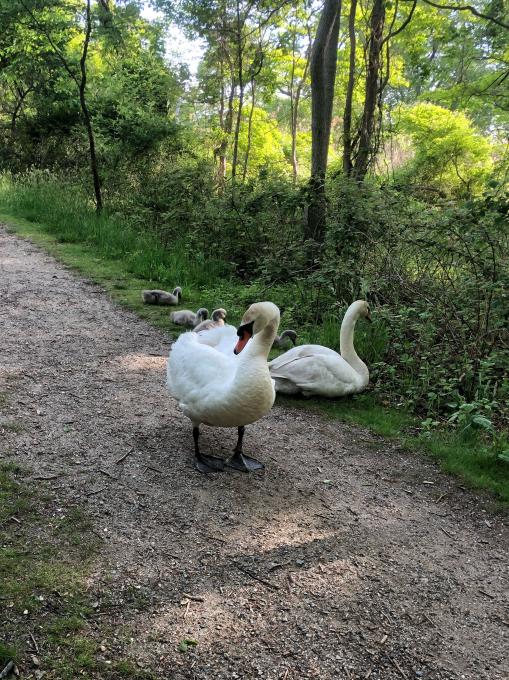 I've been fascinated by the apparently aggressive behavior of the Mute Swans in our area. I never knew such beautifuk birds could be so 'meanacing'. I've notices the 8 cygnets have whittled down to only 4. Also in this area the swans coms towards humans, and I am guessing that is looking for food as many visitors must bring food for the birds.
I've been fascinated by the apparently aggressive behavior of the Mute Swans in our area. I never knew such beautifuk birds could be so 'meanacing'. I've notices the 8 cygnets have whittled down to only 4. Also in this area the swans coms towards humans, and I am guessing that is looking for food as many visitors must bring food for the birds. 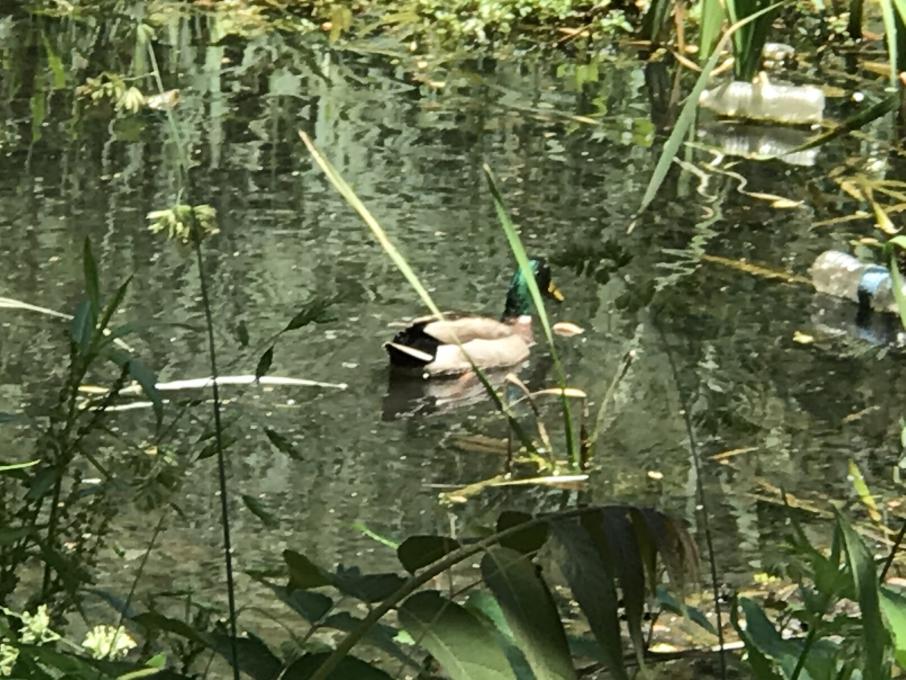

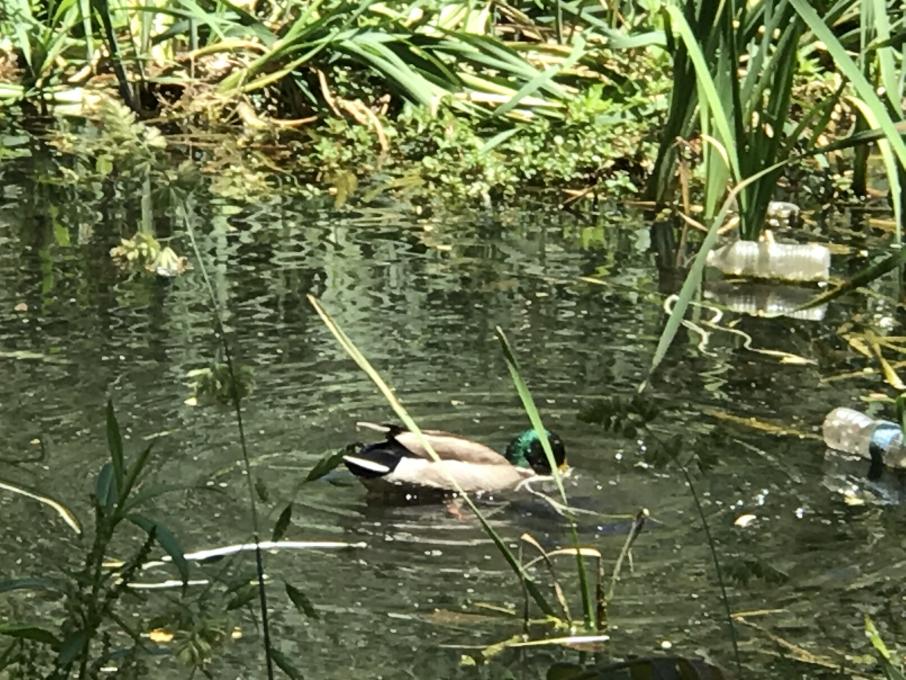
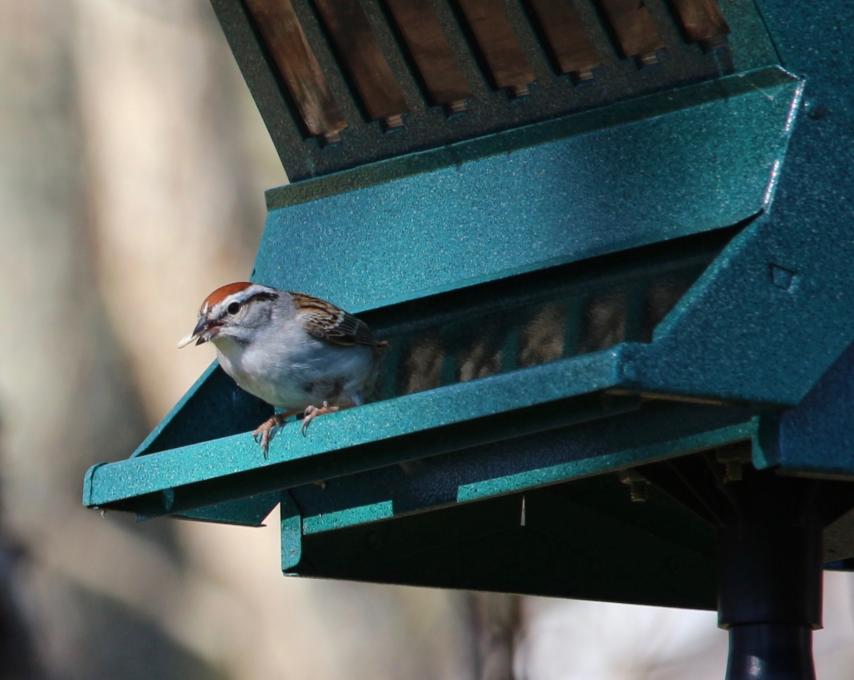 quick grab and go at the sunflower feeder. I can watch the chickadee as it approaches from nearby tree branches, and then swiftly returns (but not as swiftly as the sparrows). The sparrows, on the other hand, more particularly the song sparrow, will also drop down to the ground to continue feeding on any spillage or other things. Fun to watch the white breasted nut hatch hop down and up vertically. The downy woodpecker at my suet feeder is quite shy to movement or noise ... he/she (I have had both) seem in no hurry to fly off, unless they catch a movement from me or a noise. There is a male cardinal that seems (my imagination?) in charge of letting the rest of the bird world know what is happenning in my yard. He and the she as well, do't seem to frequent the feeders much, but he is often perched on the outside shower or somewhere else int he yard, and seems to call out after I have added seed, etc. Activity 3: songs - I love the songs, I have become more awake to the different songs and calls (albeit realizing that sometimes quite different melodies may be from the same bird-song) but I have realized that song memory is very difficult for me. OH - but, as I love to watch the hunting birds, some time ago I learned to be alert for mobbing and watch the skies - for the emergencence of a hawk being mobbed etc
quick grab and go at the sunflower feeder. I can watch the chickadee as it approaches from nearby tree branches, and then swiftly returns (but not as swiftly as the sparrows). The sparrows, on the other hand, more particularly the song sparrow, will also drop down to the ground to continue feeding on any spillage or other things. Fun to watch the white breasted nut hatch hop down and up vertically. The downy woodpecker at my suet feeder is quite shy to movement or noise ... he/she (I have had both) seem in no hurry to fly off, unless they catch a movement from me or a noise. There is a male cardinal that seems (my imagination?) in charge of letting the rest of the bird world know what is happenning in my yard. He and the she as well, do't seem to frequent the feeders much, but he is often perched on the outside shower or somewhere else int he yard, and seems to call out after I have added seed, etc. Activity 3: songs - I love the songs, I have become more awake to the different songs and calls (albeit realizing that sometimes quite different melodies may be from the same bird-song) but I have realized that song memory is very difficult for me. OH - but, as I love to watch the hunting birds, some time ago I learned to be alert for mobbing and watch the skies - for the emergencence of a hawk being mobbed etc 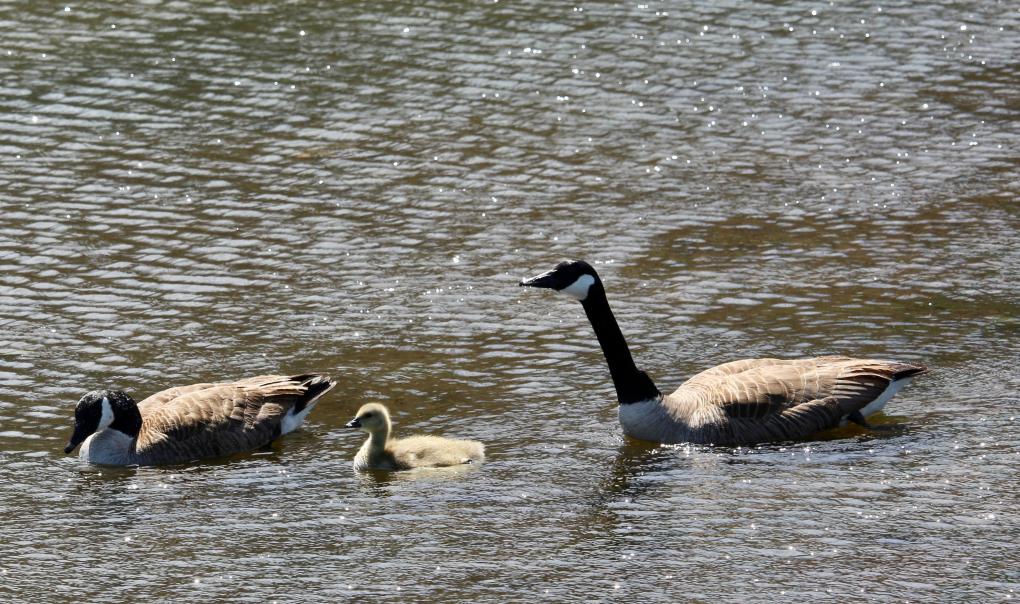

 Activity 1 : I often see White-cheeked Starlings these days while walking around my neighbour. I have not noticed them before but once recognized, they became one of my regulars. They usually walk on glass fields carelessly, looking for foods. I do not know what they eat.
Activity 1 : I often see White-cheeked Starlings these days while walking around my neighbour. I have not noticed them before but once recognized, they became one of my regulars. They usually walk on glass fields carelessly, looking for foods. I do not know what they eat.  Sorry, I had trouble posting these pictures-Pileated Woodpecker and I thought this was a Yellow Warbler at my bird feeder.
Sorry, I had trouble posting these pictures-Pileated Woodpecker and I thought this was a Yellow Warbler at my bird feeder.
